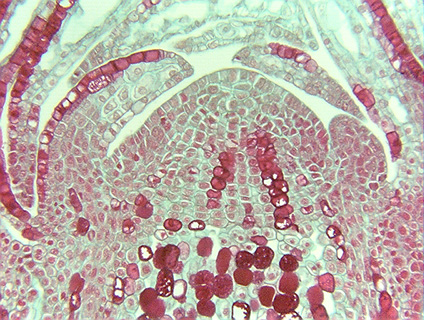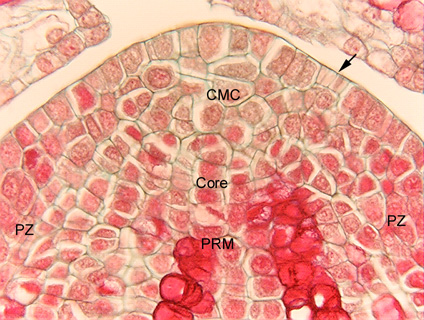 Fig. 6.3-3a and b.
Longitudinal section of a shoot apex of pine (Pinus). Pines, like all
seed plants, have shoot apical meristems without prominent single apical cells.
Instead, the shoot apical meristem consists of numerous small cells, no one of
which has any special importance. This apex is a rather typical size for seed
plant apices, and the youngest leaf primordium visible is on the right, an older
primordium is on the left (with red-stained tannins causing the epidermis to be
dark red). Most cells here are light red (due to their prominent nuclei
dominating the cells), but there are many tannin cells in the young pith and
cortex.
Fig. 6.3-3a and b.
Longitudinal section of a shoot apex of pine (Pinus). Pines, like all
seed plants, have shoot apical meristems without prominent single apical cells.
Instead, the shoot apical meristem consists of numerous small cells, no one of
which has any special importance. This apex is a rather typical size for seed
plant apices, and the youngest leaf primordium visible is on the right, an older
primordium is on the left (with red-stained tannins causing the epidermis to be
dark red). Most cells here are light red (due to their prominent nuclei
dominating the cells), but there are many tannin cells in the young pith and
cortex.
 Figure
b shows the pine apex at higher magnification. Pines and other conifers have
shoot apical meristems with a mantle-core organization. By definition, if cells
in the outermost layer undergo periclinal divisions (the new wall is parallel to
the surface of the apex), then the layer is a mantle, not a tunica. This
micrograph shows several cells produced by a periclinal division -- the cluster
of about 5 cells near the top right of the apex, where the outermost cells are
very short (arrow). All cells interior to the mantle make up the core. Notice
that near the sides and bottom of the meristem, the cells tend to be aligned in
rows whereas in the very center, the cells are in no apparent pattern. The
central cells are the central mother cells (CMC), the aligned cells make up the
peripheral zone (PZ; near the edges) and the pith-rib meristem (PRM; the tannin
cells and cells near them). There is no obvious boundary between the peripheral
zone and the pith-rib meristem.
Figure
b shows the pine apex at higher magnification. Pines and other conifers have
shoot apical meristems with a mantle-core organization. By definition, if cells
in the outermost layer undergo periclinal divisions (the new wall is parallel to
the surface of the apex), then the layer is a mantle, not a tunica. This
micrograph shows several cells produced by a periclinal division -- the cluster
of about 5 cells near the top right of the apex, where the outermost cells are
very short (arrow). All cells interior to the mantle make up the core. Notice
that near the sides and bottom of the meristem, the cells tend to be aligned in
rows whereas in the very center, the cells are in no apparent pattern. The
central cells are the central mother cells (CMC), the aligned cells make up the
peripheral zone (PZ; near the edges) and the pith-rib meristem (PRM; the tannin
cells and cells near them). There is no obvious boundary between the peripheral
zone and the pith-rib meristem.